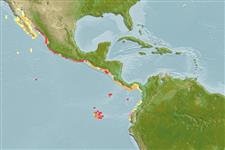Environment: milieu / climate zone / depth range / distribution range
Écologie
marin récifal; profondeur 1 - 40 m (Ref. 55763). Tropical; 33°N - 2°S, 120°W - 70°W
Eastern Pacific: Gulf of California to Ecuador, including the Galapagos Islands (Ref. 9310); and Peru (first record).
Taille / Poids / Âge
Maturity: Lm ? range ? - ? cm
Max length : 53.0 cm TL mâle / non sexé; (Ref. 55763); common length : 25.0 cm TL mâle / non sexé; (Ref. 55763)
Body oval, somewhat elongate, and compressed (depth contained less than 2.0 times in standard length); head and mouth small; teeth highly characteristic, forming a single anterior row in each jaw, incisiform and somewhat lanceolate in shape, resembling the head of a golf club, their roots compressed and horizontally set, forming a striated plate inside the mouth; vomer toothed; dorsal fin with 13 soft rays; lateral line scales 59 to 61; first anal ray longer than subsequent rays; body entirely dark gray, with dark stripes on flanks; sometimes with white spots (Ref. 55763).
Sometimes seen in schools of K. analogus, also known to school and graze with Prionurus laticlavius. Stays close to shore in shallow waters. Feeds mainly on attached algae, occasionally ingests plankton and benthic invertebrates (Ref. 28023).
Life cycle and mating behavior
Maturité | Reproduction | Frai | Œufs | Fécondité | Larves
Knudsen, S.W. and K.D. Clements, 2013. Revision of the fish family Kyphosidae (Teleostei: Perciformes). Zootaxa 3751(1):001-101. (Ref. 95491)
Statut dans la liste rouge de l'IUCN (Ref. 130435)
Menace pour l'homme
Harmless
Utilisations par l'homme
Pêcheries: intérêt commercial mineur
Plus d'informations
RéférencesAquacultureProfil d'aquacultureSouchesGénétiqueElectrophoresesHéritabilitéPathologiesTraitementNutrientsMass conversion
CollaborateursImagesStamps, Coins Misc.SonsCiguateraVitesseType de nageSurface branchialeOtolithesCerveauxVision
Outils
Articles particuliers
Télécharger en XML
Sources Internet
Estimates based on models
Preferred temperature (Ref.
123201): 18.6 - 28.4, mean 21.6 °C (based on 8 cells).
Phylogenetic diversity index (Ref.
82804): PD
50 = 0.5000 [Uniqueness, from 0.5 = low to 2.0 = high].
Bayesian length-weight: a=0.01820 (0.00772 - 0.04289), b=3.01 (2.81 - 3.21), in cm total length, based on LWR estimates for this (Sub)family-body shape (Ref.
93245).
Niveau trophique (Ref.
69278): 2.9 ±0.32 se; based on food items.
Résilience (Ref.
120179): Milieu, temps minimum de doublement de population : 1,4 à 4,4 années (Preliminary K or Fecundity.).
Fishing Vulnerability (Ref.
59153): Moderate vulnerability (41 of 100).
Nutrients (Ref.
124155): Calcium = 38.5 [20.5, 64.7] mg/100g; Iron = 0.522 [0.325, 0.810] mg/100g; Protein = 18.5 [17.3, 19.6] %; Omega3 = 0.0913 [, ] g/100g; Selenium = 36.2 [21.1, 64.8] μg/100g; VitaminA = 43.6 [12.1, 144.5] μg/100g; Zinc = 1.09 [0.77, 1.52] mg/100g (wet weight);
